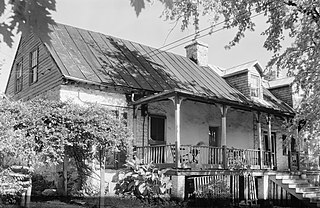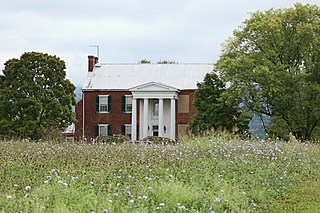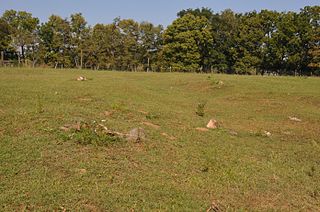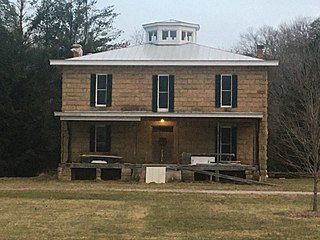
The Sloan–Parker House, also known as the Stone House, Parker Family Residence, or Richard Sloan House, is a late-18th-century stone residence near Junction, Hampshire County, in the U.S. state of West Virginia. It was built on land vacated by the Shawnee after the Native American nation had been violently forced to move west to Kansas following their defeat at the Battle of Point Pleasant in 1774. The building was added to the National Register of Historic Places on June 5, 1975, becoming Hampshire County's first property to be listed on the register. The Sloan–Parker House has been in the Parker family since 1854. The house and its adjacent farm are located along the Northwestern Turnpike in the rural Mill Creek valley.
North River Mills is a historic unincorporated community in Hampshire County in the U.S. state of West Virginia. North River Mills is located between Capon Bridge and Slanesville on Cold Stream Road at its intersection with North River Road. The village of North River Mills lies along the eastern banks of North River from which it takes its name.

Waitman Thomas Willey was an American lawyer and politician from Morgantown, West Virginia. One of the founders of the state of West Virginia during the American Civil War, he served in the United States Senate representing first the Restored Government of Virginia and became one of the new state of West Virginia's first two senators. He is one of only two people in U.S. History to represent more than one state in the U.S. Senate, the other being James Shields.

Cass is a census-designated place (CDP) and unincorporated community on the Greenbrier River in Pocahontas County, West Virginia, United States. The population was 38 at the 2020 census. The community, founded in 1901, was named for Joseph Kerr Cass, vice president and cofounder of the West Virginia Pulp and Paper Company.

White House Farm, also known as White House Tavern and the Dr. John McCormick House, listed in the National Register of Historic Places, is located in Jefferson County, West Virginia, near the small town of Summit Point, about six miles from Charles Town, West Virginia. The farm consists of a ca. 1740 farmhouse, a stone barn, a springhouse of about the same age, a wooden curing shed, and 60+ acres of pasture and woods. The farm is one of the oldest in the county and has a rich history.

The Peter G. Van Winkle House was a historic home located in the Julia-Ann Square Historic District in Parkersburg, Wood County, West Virginia. It was built between about 1880 and 1899, and was a two-story duplex in the Queen Anne style. It featured a deck hipped roof with intersecting gables, turrets, and dormers. It was built on property once owned by former United States Senator Peter G. Van Winkle, who died in 1872.

The Kennedy Farm is a National Historic Landmark property on Chestnut Grove Road in rural southern Washington County, Maryland. It is notable as the place where the radical abolitionist John Brown planned and began his raid on Harpers Ferry, Virginia, in 1859. Also known as the John Brown Raid Headquarters and Kennedy Farmhouse, the log, stone, and brick building has been restored to its appearance at the time of the raid. The farm is now owned by a preservation nonprofit.

The Shepherdstown Historic District comprises the historic core of Shepherdstown, West Virginia. The town is the oldest in West Virginia, founded in 1762 as Mecklenburg. No structures are known to exist from the time before the town became known as Shepherdstown. The historic district is concentrated along German Street, the main street, with 386 contributing resources and 69 non-contributing elements. The chief representative period is the late 18th century, with many Federal style brick houses. German Street is also furnished with 19th-century "street furniture" such as metal fences, mounting blocks, wooden pumps and mature trees.

Scanlon Farm is a late 19th-century loghouse and farm overlooking Three Churches Run east of the unincorporated community of Three Churches, West Virginia. It was listed on the National Register of Historic Places on February 3, 1988.

Pleasant Hill Plantation, also known as Van Leer Place, is a historic stone farmhouse located near Glen Moore in West Nantmeal Township, Chester County, Pennsylvania.

Fort Van Meter — or Fort VanMeter — is a mid-18th century frontier fort in the South Branch Potomac River Valley about 9 miles (14 km) southwest of Romney in Hampshire County, West Virginia, USA. It is located 15 miles (24 km) northeast of Moorefield and about a mile northeast of the former community of Glebe at the northern end of the rugged river gorge known as The Trough.

Fort Pleasant — formerly known as Fort Van Meter and Town Fort and still also known as the Isaac Van Meter House — is a historic site located near the unincorporated community of Old Fields about 5 miles north of Moorefield in Hardy County, West Virginia, U.S. Situated on the South Branch Potomac River, a young Colonel George Washington directed a fortification to be built here in 1756 during the escalating hostilities with Native Americans and French known as the French and Indian War. The fierce skirmish known as the Battle of the Trough occurred about a mile and a half away the same year. The existing Federal style house, built just after the American Revolution, was listed on the National Register of Historic Places in 1973.

John Drinker House is a historic home located at Bunker Hill, Berkeley County, West Virginia. It was built about 1815 and is a two-story, five-bay, limestone dwelling in the Federal style. It features an arched stone main entrance. The property includes the ruins of a log home that pre-dates the Drinker House, ruins of a stone smokehouse, and the ruins of slave quarters. A dump pile is also located on the property. The house was built by John Drinker (1760–1826), a Quaker portrait artist from Philadelphia. The house is believed to have been a stop on the Underground Railroad.

Edgewood, also known as the John Boyd House, is a historic home located at Bunker Hill, Berkeley County, West Virginia. It was built in 1839 and is a two-story, five-bay, brick dwelling with a gable roof in the Greek Revival style. The entrance features a semi-elliptical transom and sidelights. The building has a two-story rear ell. The property includes a small log slave cabin.

John, David, and Jacob Rees House, also known as Lefevre Farm, is a historic home located at Bunker Hill, Berkeley County, West Virginia. It is an L-shaped, log, stone-and-brick dwelling on a stone foundation. It measures 45 feet wide by 70 feet deep, and was built in three sections, the oldest, three-bay log section dating to about 1760. The two-story, three-bay rubble stone section is in the Federal style and built in 1791. The front section was built about 1855 and is a five-bay-wide, 2+1⁄2-story building in the Greek Revival style. Also on the property is a small stone spring house and log barn.

Nathan VanMetre House is a historic home located near Martinsburg, Berkeley County, West Virginia. It was built in 1872, and is a two-story, eight bay wide rectangular brick house with a steeply pitched gable roof, in the Greek Revival style. The main section of the house is five bays wide. Also on the property is a small brick smokehouse (1872), large bank barn (1872), garage, two silos, and chicken house.

Thomas VanMetre or Vanmetre House is a historic home located near Martinsburg, Berkeley County, West Virginia, USA. It was built in 1838 and is a two-story, five-bay, red brick vernacular "I"-house. It has a side gable roof and a single bay, pedimented portico supported by Doric order columns. Also on the property is summer kitchen.

Wildwood, also known as the General Alfred Beckley Home, is a historic home located at Beckley, Raleigh County, West Virginia. The house is open as the Wildwood House Museum and was listed on the National Register of Historic Places in 1970.

Halfway House, also known as the Tyree Tavern, is a historic inn and tavern located at Ansted, Fayette County, West Virginia. It is a two-story, log and frame building with a gable roof measuring 50 feet long and 20 feet deep. The original log section was built prior to 1810. It was expanded to its present configuration about 1827. It served as a stage coach stop on the James River and Kanawha Turnpike. Notable guests included Daniel Webster, Henry Clay, and John Breckenridge. It also was headquarters of the Chicago Gray Dragoons during the American Civil War. It was listed on the National Register of Historic Places in 1978.

Gen. John McCausland House, also known as "Grape Hill," is a historic home located near Pliny, Mason County, West Virginia. The main house was built in 1885, and is a two-story sandstone residence. It features a full-length, one story, five bay porch with fluted Doric order columns and metal covered hip roof. The house was built by Confederate General John McCausland (1836–1927). The boundary increase expanded the listing to include 23 additional contributing buildings and 4 contributing structures and designated it a national historic district. They include a variety of farm-related outbuildings and a log house.






















